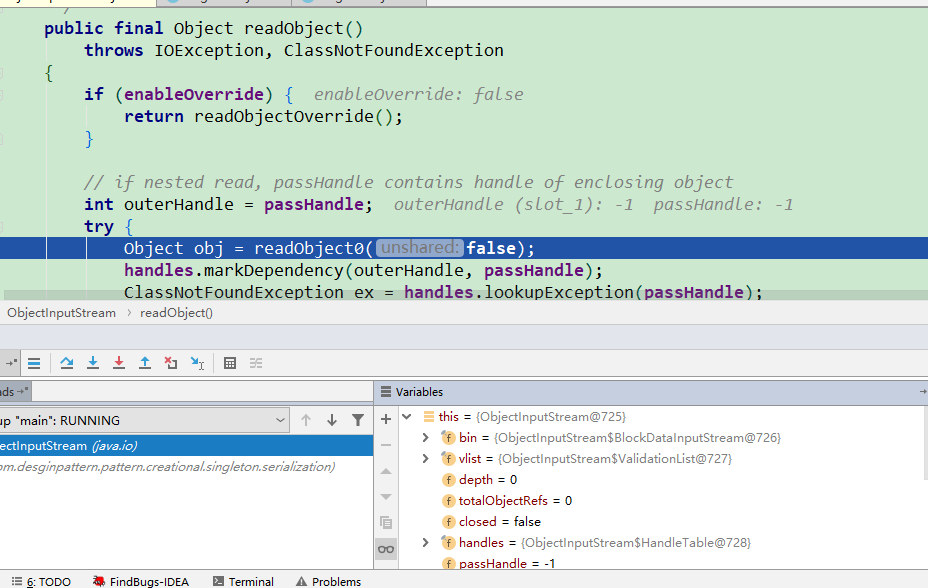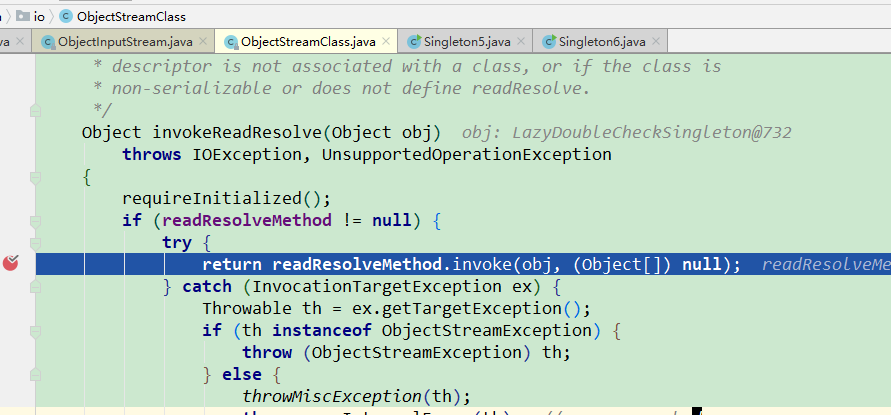單例模式介紹 單例模式,是為了確保在整個軟體體統中,某個類對象只有一個實例,並且該類通常會提供一個對外獲取該實例的public方法(靜態方法)。 比如日誌、資料庫連接池等對象,通常需要且只需要一個實例對象,這就會使用單例模式。 單例模式的八種模式 餓漢式(靜態常量) 餓漢式(靜態代碼塊) 懶漢式(線 ...
單例模式介紹
單例模式,是為了確保在整個軟體體統中,某個類對象只有一個實例,並且該類通常會提供一個對外獲取該實例的public方法(靜態方法)。
比如日誌、資料庫連接池等對象,通常需要且只需要一個實例對象,這就會使用單例模式。
單例模式的八種模式
- 餓漢式(靜態常量)
- 餓漢式(靜態代碼塊)
- 懶漢式(線程不安全)
- 懶漢式(同步方法)
- 懶漢式(同步代碼塊)
- 懶漢式(雙重檢查)
- 靜態內部類
- 枚舉
下麵依次來說明一下:
餓漢式(靜態常量)
通常,我們創建一個對象的方式就是new,但是,當我們考慮只創建一個實例的時候,就應該禁止外部來通過new的方式進行創建。同時,由於無法使用new,你應該考慮提供一個獲取單例對象的方式給別人。
思路
1.將構造器私有化(防止外部new,但是對反射還是有局限)
2.類的內部創建對象
3.對外提供一個獲取實例靜態的public方法
代碼實現:
public class Singleton1 {
public static void main(String[] args) {
HungrySingleton hungrySingleton = HungrySingleton.getInstance();
HungrySingleton hungrySingleton1 = HungrySingleton.getInstance();
System.out.println(hungrySingleton == hungrySingleton1);
}
}
class HungrySingleton {
//1.私有化構造器
private HungrySingleton() {
}
// 2.類內部創建對象,因為步驟3是static的,
// 所以實例對象是static的
private final static HungrySingleton instance = new HungrySingleton();
//3.對外提供一個獲取對象的方法,
// 因為調用方式的目的就是為了獲取對象,
// 所以該方法應該是static的。
public static HungrySingleton getInstance() {
return instance;
}
}運行程式顯示,我們的確只創建了一個對象實例。
小結
優點:代碼實現比較簡單,在類載入的時候就完成了實例化,同時,該方式能夠避免線程安全問題。
缺點:在類裝載的時候就完成實例化,沒有達到Lazy Loading的效果。如果從始至終從未使用過這個實例,則會造成記憶體的浪費。
這種方式基於classloder機制避免了多線程的同步問題,不過, instance在類裝載時就實例化,在單例模式中大多數都是調用getInstance方法, 但是導致類裝載的原因有很多種, 因此不能確定有其他的方式(或者其他的靜態方法)導致類裝載,這時候初始化instance就沒有達到lazy loading的效果。
總結:這種單例模式可以使用,但是可能造成記憶體的浪費。
餓漢式(靜態代碼塊)
該方式和第一種區別不大,只是將創建實例放在了靜態代碼塊中。
由於無法使用new,你應該考慮提供一個獲取單例對象的方式給別人。
思路
1.將構造器私有化(防止外部new,但是對反射還是有局限)
2.類的內部創建對象(通過靜態代碼塊)
3.對外提供一個獲取實例靜態的public方法
代碼實現:
public class Singleton2 {
public static void main(String[] args) {
HungrySingleton hungrySingleton = HungrySingleton.getInstance();
HungrySingleton hungrySingleton1 = HungrySingleton.getInstance();
System.out.println(hungrySingleton == hungrySingleton1);
}
}
class HungrySingleton {
//1.私有化構造器
private HungrySingleton() {
}
// 2.類內部創建對象,因為步驟3是static的,
// 所以實例對象是static的
private final static HungrySingleton instance;
static {
instance = new HungrySingleton();
}
//3.對外提供一個獲取對象的方法,
// 因為調用方式的目的就是為了獲取對象,
// 所以該方法應該是static的。
public static HungrySingleton getInstance() {
return instance;
}
}小結
該方式只是將對象的創建放在靜態代碼塊中,其優點和缺點與第一種方式完全一樣。
總結:這種單例模式可以使用,但是可能造成記憶體的浪費。(同第一種)
懶漢式(線程不安全)
該方式的主要思想就是為了改善餓漢式的缺點,通過懶載入(在使用的時候再去載入),達到節約記憶體的目的。
由於無法使用new,你應該考慮提供一個獲取單例對象的方式給別人。
思路
1.將構造器私有化(防止外部new,但是對反射還是有局限)
2.類的內部創建對象,懶載入,在使用的時候才去載入
3.對外提供一個獲取實例靜態的public方法
代碼實現:
public class Singleton3 {
public static void main(String[] args) {
TestThread testThread = new TestThread();
Thread thread = new Thread(testThread);
Thread thread1 = new Thread(testThread);
thread.start();
thread1.start();
}
}
class LazySingleton {
//1.私有化構造器
private LazySingleton() {}
//2.類的內部聲明對象
private volatile static LazySingleton instance;
//3.對外提供獲取對象的方法
public static LazySingleton getInstance() {
//判斷類是否被初始化
if (instance == null) {
//第一次使用的時候,創建對象
instance = new LazySingleton();
}
return instance;
}
}
class TestThread implements Runnable {
@Override
public void run() {
System.out.println("線程" + Thread.currentThread().getName() + "開始執行");
try {
//為了演示多線程情況
Thread.sleep(100);
} catch (InterruptedException e) {
e.printStackTrace();
}
LazySingleton instance = LazySingleton.getInstance();
System.out.println("線程" + Thread.currentThread().getName() + "初始化對象" + instance.hashCode());
}
}執行程式後,發現了問題:
//運行結果:
線程Thread-0開始執行
線程Thread-1開始執行
線程Thread-1初始化對象1391273746
線程Thread-0初始化對象547686109小結
優點:起到了懶載入的作用,但是只能在單線程情況下使用。
缺點:多線程下不安全,如果一個線程進入到if語句中阻滯(還未開始創建對象),另一線程進入並通過了if判斷,則會創建多個實例,這一點就違背了單例的目的。
結論:實際情況下,不要使用這種方式。
懶漢式(線程安全,同步方法)
思路
同上一中方式一樣,但是為瞭解決多線程安全問題,使用同步方法。
代碼演示:
public class Singleton4 {
public static void main(String[] args) {
TestThread testThread = new TestThread();
Thread thread = new Thread(testThread);
Thread thread1 = new Thread(testThread);
thread.start();
thread1.start();
}
}
class LazySingleton {
//1.私有化構造器
private LazySingleton() {}
//2.類的內部聲明對象
private volatile static LazySingleton instance;
//3.對外提供獲取對象的方法
public synchronized static LazySingleton getInstance() {
//判斷類是否被初始化
if (instance == null) {
//第一次使用的時候,創建對象
instance = new LazySingleton();
}
return instance;
}
}
class TestThread implements Runnable {
@Override
public void run() {
System.out.println("線程" + Thread.currentThread().getName() + "開始執行");
try {
//為了演示多線程情況
Thread.sleep(100);
} catch (InterruptedException e) {
e.printStackTrace();
}
LazySingleton instance = LazySingleton.getInstance();
System.out.println("線程" + Thread.currentThread().getName() + "初始化對象" + instance.hashCode());
}
}運行結果如下所示:
線程Thread-1開始執行
線程Thread-0開始執行
線程Thread-0初始化對象681022576
線程Thread-1初始化對象681022576小結
優點:起到了懶載入的效果,同時,解決了線程安全問題。
缺點:效率低下,每次想要獲取對象的時候,去執行getInstance()都是通過同步方法。而且,初始化對象後,再次使用的時候,應該直接return這個對象。
總結:可以在多線程條件下使用,但是效率低下,不推薦。
懶漢式(線程安全,同步代碼塊)
思路
同樣是為瞭解決多線程安全問題,不過採用的是同步代碼塊。首先,最先想到的是:
1.將getInstance()方法體全部加上同步鎖。
代碼實現:
public class Singleton5 {
public static void main(String[] args) {
TestThread testThread = new TestThread();
Thread thread = new Thread(testThread);
Thread thread1 = new Thread(testThread);
thread.start();
thread1.start();
}
}
//對getInstance()的方法體整體加同步代碼塊
class LazySingleton {
//1.私有化構造器
private LazySingleton() {}
//2.類的內部聲明對象
private volatile static LazySingleton instance;
//3.對外提供獲取對象的方法
public static LazySingleton getInstance() {
//同步代碼塊
synchronized (LazySingleton.class) {
//判斷類是否被初始化
if (instance == null) {
//第一次使用的時候,創建對象
instance = new LazySingleton();
}
}
return instance;
}
}
class TestThread implements Runnable {
@Override
public void run() {
System.out.println("線程" + Thread.currentThread().getName() + "開始執行");
try {
//為了演示多線程情況
Thread.sleep(100);
} catch (InterruptedException e) {
e.printStackTrace();
}
LazySingleton instance = LazySingleton.getInstance();
// LazySingleton1 instance = LazySingleton1.getInstance();
System.out.println("線程" + Thread.currentThread().getName() + "初始化對象" + instance.hashCode());
}
}運行的結果:
線程Thread-0開始執行
線程Thread-1開始執行
線程Thread-1初始化對象1419349448
線程Thread-0初始化對象1419349448這種方式的優缺點和同步方法一樣,能夠實現多線程安全,但是效率低下。那麼,能不能提高一下效率呢?我們發現,每次調用getInstance()的時候,都要進入同步代碼塊,但是,一旦對象初始化後,第二次使用的時候,應該能夠直接獲取這個對象才對。
按照這個思路,對代碼進行更改(為了說明這個,新建一個類LazySingleton1):
2.只在初始化對象部分加上同步鎖
代碼實現:
//為了提高效率,通過if判斷,初始化之前進入同步鎖
class LazySingleton1 {
//1.私有化構造器
private LazySingleton1() {}
//2.類的內部聲明對象
private volatile static LazySingleton1 instance;
//3.對外提供獲取對象的方法
public static LazySingleton1 getInstance() {
//判斷類是否被初始化
if (instance == null) {
//第一次使用的時候,創建對象
synchronized (LazySingleton1.class) {
instance = new LazySingleton1();
}
}
return instance;
}將類TestClass的run()方法進行更改,獲取的實例改為LazySingleton1類型。代碼看上去沒有問題,那麼運行效果如何呢:
//運行結果:
線程Thread-1開始執行
線程Thread-0開始執行
線程Thread-1初始化對象1368942806
線程Thread-0初始化對象1187311731那麼,我們發現,打臉了,多線程情況下,創建了兩個對象,並未達到單例的目的。
小結
- 對整個方法體加同步代碼塊
可以達到要求,優缺點同同步方法。 - 只在初始化對象的代碼添加同步鎖
不能滿足線程安全要求,實際工作中,不能使用這種方式。
懶漢式(線程安全,雙重檢查機制)
思路
針對懶漢式的多線程問題,我們可謂是操碎了心:同步方法可以解決問題,但是效率太低了;同步代碼塊則根本不能保證多線程安全。如何能做到“魚和熊掌兼得”呢?既然同步代碼塊的效率較好,那麼我們就針對這個方式進行改良:雙重檢查機制,即在getInstance()內進行兩次檢查,第一次通過if判斷後,初始化對象之前,進行同步並再次進行判斷。這樣做的目的:既能解決線程安全問題,同時避免第二次使用對象的時候還要執行同步的代碼。
代碼實現:
public class Singleton6 {
public static void main(String[] args) {
TestThread testThread = new TestThread();
Thread thread = new Thread(testThread);
Thread thread1 = new Thread(testThread);
thread.start();
thread1.start();
}
}
class LazyDoubleCheckSingleton {
//1.私有化構造器
private LazyDoubleCheckSingleton() {}
//2.類的內部聲明對象
private volatile static LazyDoubleCheckSingleton instance;
//3.對外提供獲取對象的方法
public static LazyDoubleCheckSingleton getInstance() {
//判斷類是否被初始化
if (instance == null) {
//第一次使用,通過if判斷
//加鎖
synchronized (LazyDoubleCheckSingleton.class) {
//拿到鎖後,初始化對象之前,再次進行判斷
if (instance == null) {
instance = new LazyDoubleCheckSingleton();
}
}
}
return instance;
}
}
class TestThread implements Runnable {
@Override
public void run() {
System.out.println("線程" + Thread.currentThread().getName() + "開始執行");
try {
//為了演示多線程情況
Thread.sleep(100);
} catch (InterruptedException e) {
e.printStackTrace();
}
LazyDoubleCheckSingleton instance = LazyDoubleCheckSingleton.getInstance();
System.out.println("線程" + Thread.currentThread().getName() + "初始化對象" + instance.hashCode());
}
}運行結果如下所示:
//運行結果:
線程Thread-0開始執行
線程Thread-1開始執行
線程Thread-1初始化對象996963733
線程Thread-0初始化對象996963733小結
優點:
- 解決了上一種方式中的線程安全問題,同時實現了延遲載入的效果,節約記憶體;
- 第二次使用的時候,if判斷為false,直接返回創建好的對象,避免進入同步代碼,提高了效率;
結論:推薦使用這種方式,實際工作中也比較常見這種方式。
靜態內部類
思路
為了實現多線程情況下安全,除了手工加鎖,還有別的方式。現在,我們採用靜態內部類的方式。這種方式利用了JVM載入類的機制來保證只初始化一個對象。
思路同樣是私有化構造器,對外提供靜態的公開方法;不同之處是,類的創建交給靜態內部類來時實現。
代碼實現
public class Singleton7 {
public static void main(String[] args) {
TestThread testThread = new TestThread();
Thread thread = new Thread(testThread);
Thread thread1 = new Thread(testThread);
thread.start();
thread1.start();
}
}
class StaticInnerSingleton {
// 1.構造器私有化
private StaticInnerSingleton() {}
// 2.通過靜態內部類來初始化對象
private static class InnerClass {
private static final StaticInnerSingleton INSTANCE = new StaticInnerSingleton();
}
// 3.對外提供獲取對象的方法
public static StaticInnerSingleton getInstance() {
return InnerClass.INSTANCE;
}
}
class TestThread implements Runnable {
@Override
public void run() {
System.out.println("線程" + Thread.currentThread().getName() + "開始執行");
try {
//為了演示多線程情況
Thread.sleep(100);
} catch (InterruptedException e) {
e.printStackTrace();
}
StaticInnerSingleton instance = StaticInnerSingleton.getInstance();
System.out.println("線程" + Thread.currentThread().getName() + "初始化對象" + instance.hashCode());
}
}運行結果:
線程Thread-0開始執行
線程Thread-1開始執行
線程Thread-0初始化對象1326533480
線程Thread-1初始化對象1326533480OK,我們發現,這種方式達到了預期的效果。
小結
優點:
- 這種靜態內部類的方式,通過類載入機制來保證了初始化實例時只有一個實例。
- 類的靜態屬性只有在第一次載入類的時候初始化,而JVM能保證線程安全,在類的初始化過程中,只有一個線程能進入並完成初始化。
- 靜態內部類方式實現了懶載入的效果,這種方式不會在類StaticInnerSingleton載入的時候進行初始化,而是在第一次使用時調用getInstance()方法初始化,能夠起到節約內次的目的。
- 該方式的getInstance()方法,通過調用靜態內部類的靜態屬性返回實例對象,避免了每次調用時進行同步,效率高。
結論:線程安全,效率高,代碼實現簡單,推薦使用。
枚舉
思路
在靜態內部類的方式中,我們借用了JVM的類載入機制來實現了功能,同樣,還可以借用Java的枚舉來實現單例模式。
public class Singleton8 {
public static void main(String[] args) {
TestThread testThread = new TestThread();
Thread thread = new Thread(testThread);
Thread thread1 = new Thread(testThread);
thread.start();
thread1.start();
}
}
enum EnumSingleton {
INSTANCE;
public void sayHi() {
System.out.println("Hi, " + INSTANCE);
}
}
class TestThread implements Runnable {
@Override
public void run() {
System.out.println("線程" + Thread.currentThread().getName() + "開始執行");
try {
//為了演示多線程情況
Thread.sleep(100);
} catch (InterruptedException e) {
e.printStackTrace();
}
EnumSingleton instance = EnumSingleton.INSTANCE;
System.out.println("線程" + Thread.currentThread().getName() + "初始化對象" + instance.hashCode());
}
}運行結果如下:
線程Thread-0開始執行
線程Thread-1開始執行
線程Thread-1初始化對象1134798663
線程Thread-0初始化對象1134798663小結
優點:這中方式需要在JDK1.5以上的版本中使用,利用枚舉來實現單例模式。不僅能避免多線程同步問題,而且還能防止反序列化重新創建新的對象。在《Effective Java》中提到了這種方式,其作者推薦。
結論:推薦使用。
單例模式的序列化漏洞
在上面的枚舉類的總結中,我們提高枚舉方式能夠避免反序列化對象的時候重新建立新的對象(反序列化漏洞),那麼什麼是反序列化漏洞呢?Java對象進行反序列化的時候會通過反射機制來創建實例,反射機制的存在使得我們可以越過Java本身的靜態檢查和類型約束,在運行期直接訪問和修改目標對象的屬性和狀態。這裡理解的不是很準確,有錯誤的話請指出。
代碼演示:
public class Test {
public static void main(String[] args) throws IOException, ClassNotFoundException {
// HungrySingleton instance = HungrySingleton.getInstance();
// //序列化
// ObjectOutputStream oos = new ObjectOutputStream(new FileOutputStream("serializable_singleton"));
// oos.writeObject(instance);
//
// //反序列化
// ObjectInputStream ois = new ObjectInputStream(new FileInputStream("serializable_singleton"));
// HungrySingleton newInstance = (HungrySingleton) ois.readObject();
LazyDoubleCheckSingleton instance = LazyDoubleCheckSingleton.getInstance();
//序列化
ObjectOutputStream oos = new ObjectOutputStream(new FileOutputStream("serializable_singleton"));
oos.writeObject(instance);
//反序列化
ObjectInputStream ois = new ObjectInputStream(new FileInputStream("serializable_singleton"));
LazyDoubleCheckSingleton newInstance = (LazyDoubleCheckSingleton) ois.readObject();
System.out.println(instance);
System.out.println(newInstance);
System.out.println(instance == newInstance);
}
}
class HungrySingleton implements Serializable {
private static final long serialVersionUID = -4913346286867374832L;
//1.私有化構造器
private HungrySingleton() {
}
// 2.類內部創建對象,因為步驟3是static的,
// 所以實例對象是static的
private final static HungrySingleton instance;
static {
instance = new HungrySingleton();
}
//3.對外提供一個獲取對象的方法,
// 因為調用方式的目的就是為了獲取對象,
// 所以該方法應該是static的。
public static HungrySingleton getInstance() {
return instance;
}
//解決單例模式的反序列化漏洞
// public Object readResolve() {
// return instance;
// }
}
class LazyDoubleCheckSingleton implements Serializable {
private static final long serialVersionUID = -8459475238793042042L;
//1.私有化構造器
private LazyDoubleCheckSingleton() {}
//2.類的內部聲明對象
private volatile static LazyDoubleCheckSingleton instance;
//3.對外提供獲取對象的方法
public static LazyDoubleCheckSingleton getInstance() {
//判斷類是否被初始化
if (instance == null) {
//第一次使用,通過if判斷
//加鎖
synchronized (LazyDoubleCheckSingleton.class) {
//拿到鎖後,初始化對象之前,再次進行判斷
if (instance == null) {
instance = new LazyDoubleCheckSingleton();
}
}
}
return instance;
}
// public Object readResolve() {
// return instance;
// }
}這裡,我們分別提供了懶漢式和餓漢式(雙重檢查)來驗證這個現象。運行後會報錯,實現Serializable介面後能夠正常運行,結果如下:
com.bm.desginpattern.pattern.creational.singleton.serialization.LazyDoubleCheckSingleton@7f31245a
com.bm.desginpattern.pattern.creational.singleton.serialization.LazyDoubleCheckSingleton@6d03e736
false創建了兩個對象,沒有實現多線程安全。首先說明一下解決方案,然後再講解一下原理。我們發現餓漢式還是懶漢式都新增了一個方法readResolve(),將註釋取消後,再次運行的結果如下:
com.bm.desginpattern.pattern.creational.singleton.serialization.LazyDoubleCheckSingleton@7f31245a
com.bm.desginpattern.pattern.creational.singleton.serialization.LazyDoubleCheckSingleton@7f31245a
true奇跡出現了,只是增加一個方法,情況完全不同了。那麼背後的原理是什麼呢?我們通過debug來講解:

1.在23行打一個斷點,進入併進入該方法:

2.我們發現,該方法首先是進行一些判斷,然後執行readObject0()方法,進入該方法查看:

//該方法完成代碼
private Object readObject0(boolean unshared) throws IOException {
boolean oldMode = bin.getBlockDataMode();
if (oldMode) {
int remain = bin.currentBlockRemaining();
if (remain > 0) {
throw new OptionalDataException(remain);
} else if (defaultDataEnd) {
/*
* Fix for 4360508: stream is currently at the end of a field
* value block written via default serialization; since there
* is no terminating TC_ENDBLOCKDATA tag, simulate
* end-of-custom-data behavior explicitly.
*/
throw new OptionalDataException(true);
}
bin.setBlockDataMode(false);
}
byte tc;
while ((tc = bin.peekByte()) == TC_RESET) {
bin.readByte();
handleReset();
}
depth++;
totalObjectRefs++;
try {
switch (tc) {
case TC_NULL:
return readNull();
case TC_REFERENCE:
return readHandle(unshared);
case TC_CLASS:
return readClass(unshared);
case TC_CLASSDESC:
case TC_PROXYCLASSDESC:
return readClassDesc(unshared);
case TC_STRING:
case TC_LONGSTRING:
return checkResolve(readString(unshared));
case TC_ARRAY:
return checkResolve(readArray(unshared));
case TC_ENUM:
return checkResolve(readEnum(unshared));
case TC_OBJECT:
return checkResolve(readOrdinaryObject(unshared));
case TC_EXCEPTION:
IOException ex = readFatalException();
throw new WriteAbortedException("writing aborted", ex);
case TC_BLOCKDATA:
case TC_BLOCKDATALONG:
if (oldMode) {
bin.setBlockDataMode(true);
bin.peek(); // force header read
throw new OptionalDataException(
bin.currentBlockRemaining());
} else {
throw new StreamCorruptedException(
"unexpected block data");
}
case TC_ENDBLOCKDATA:
if (oldMode) {
throw new OptionalDataException(true);
} else {
throw new StreamCorruptedException(
"unexpected end of block data");
}
default:
throw new StreamCorruptedException(
String.format("invalid type code: %02X", tc));
}
} finally {
depth--;
bin.setBlockDataMode(oldMode);
}
}我們發現,該方法還是對傳入的對象進行一些判斷,在這裡,我們匹配到TC_OBJECT,執行對應的方法。
3.進入該方法:

4.進一步查看:

我們看到一個名為resolveEx的屬性,說明很接近了。
5.繼續往下調試:


我們發現,這三個條件都滿足,因為我們在LazyDoubleCheckSingleton類中定義了readResolve()方法。

6.if判斷通過,進入到下一個方法:

7.在該方法中,我們發現經過一些條件判斷後,通過反射方式來調用我們在類LazyDoubleCheckSingleton中新定義的方法readResolve():

- 如果我們沒有新增這個方法,反射的時候會新建一個LazyDoubleCheckSingleton對象,並將其返回;
當我們新增這個readResolve()的時候,反射的時候還是會創建一個新的對象,但是,返回的是我們在readResolve()中的定義的返回對象。從而達到了多線程安全的目的。
單例模式的反射
未完待續



